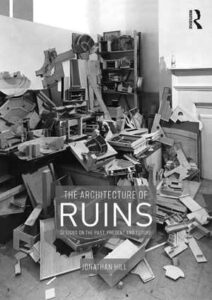نام کتاب: The Architecture Of Ruins – Designs On The Past, Present And Future
نویسنده: Jonathan Hill
ویرایش: ۱
سال انتشار: ۲۰۱۹
کد ISBN کتاب: ۱۱۳۸۳۶۷۷۷X, 9781138367777,
فرمت: PDF
تعداد صفحه: ۳۵۸
حجم کتاب: ۲۴ مگابایت
کیفیت کتاب: OCR
انتشارات: Routledge
Description About Book The Architecture Of Ruins – Designs On The Past, Present And Future From Amazon
The Architecture of Ruins: Designs on the Past, Present and Future identifies an alternative and significant history of architecture from the sixteenth century to the twenty-first century, in which a building is designed, occupied and imagined as a ruin. This design practice conceives a monument and a ruin as creative, interdependent and simultaneous themes within a single building dialectic, addressing temporal and environmental questions in poetic, psychological and practical terms, and stimulating questions of personal and national identity, nature and culture, weather and climate, permanence and impermanence and life and death. Conceiving a building as a dialogue between a monument and a ruin intensifies the already blurred relations between the unfinished and the ruined and envisages the past, the present and the future in a single architecture.
Structured around a collection of biographies, this book conceives a monument and a ruin as metaphors for a life and means to negotiate between a self and a society. Emphasising the interconnections between designers and the particular ways in which later architects learned from earlier ones, the chapters investigate an evolving, interdisciplinary design practice to show the relevance of historical understanding to design. Like a history, a design is a reinterpretation of the past that is meaningful to the present. Equally, a design is equivalent to a fiction, convincing users to suspend disbelief. We expect a history or a novel to be written in words, but they can also be delineated in drawing, cast in concrete or seeded in soil. The architect is a ‘physical novelist’ as well as a ‘physical historian’.
Like building sites, ruins are full of potential. In revealing not only what is lost, but also what is incomplete, a ruin suggests the future as well as the past. As a stimulus to the imagination, a ruin’s incomplete and broken forms expand architecture’s allegorical and metaphorical capacity, indicating that a building can remain unfinished, literally and in the imagination, focusing attention on the creativity of users as well as architects. Emphasising the symbiotic relations between nature and culture, a building designed, occupied and imagined as a ruin acknowledges the coproduction of multiple authors, whether human, non-human or atmospheric, and is an appropriate model for architecture in an era of increasing climate change.
درباره کتاب The Architecture Of Ruins – Designs On The Past, Present And Future ترجمه شده از گوگل
معماری خرابهها: طرحهایی در گذشته، حال و آینده، تاریخ جایگزین و قابل توجهی از معماری را از قرن شانزدهم تا قرن بیست و یکم شناسایی میکند که در آن ساختمانی بهعنوان یک ویرانه طراحی، اشغال و تصور میشود. این شیوه طراحی یک بنای تاریخی و یک ویرانه را به عنوان مضامینی خلاقانه، وابسته به هم و همزمان در یک دیالکتیک ساختمانی تصور میکند که به پرسشهای زمانی و محیطی در قالبهای شاعرانه، روانشناختی و عملی میپردازد و پرسشهای هویت شخصی و ملی، طبیعت و فرهنگ، آبوهوا و آب و هوا و … آب و هوا، دوام و ناپایداری و زندگی و مرگ. تصور یک ساختمان به مثابه گفتگوی بین بنای تاریخی و خرابه، روابط مبهم بین ناتمام و خراب را تشدید می کند و گذشته، حال و آینده را در یک معماری واحد تجسم می کند.
این کتاب که حول مجموعهای از زندگینامهها ساخته شده است، یک بنای تاریخی و یک ویرانه را به عنوان استعارهای از یک زندگی و ابزاری برای مذاکره بین خود و جامعه در نظر میگیرد. این فصل ها با تأکید بر ارتباطات متقابل بین طراحان و روش های خاصی که معماران بعدی از معماران قبلی آموختند، به بررسی یک رویه طراحی در حال تکامل و بین رشته ای می پردازند تا ارتباط درک تاریخی را با طراحی نشان دهند. مانند یک تاریخ، یک طرح یک تفسیر مجدد از گذشته است که برای زمان حال معنادار است. به همین ترتیب، یک طرح معادل یک داستان تخیلی است که کاربران را متقاعد می کند که ناباوری را متوقف کنند. ما انتظار داریم که یک تاریخ یا یک رمان با کلمات نوشته شود، اما می توان آنها را در نقاشی ترسیم کرد، در بتن ریخته یا در خاک بذر کرد. معمار یک “رمان نویس فیزیکی” و همچنین “مورخ فیزیک” است.
مانند سایت های ساختمانی، ویرانه ها پر از پتانسیل هستند. در آشکار کردن نه تنها چیزهایی که از دست رفته، بلکه آنچه ناقص است، ویرانه، آینده و همچنین گذشته را نشان می دهد. به عنوان محرکی برای تخیل، فرم های ناقص و شکسته یک خرابه ظرفیت تمثیلی و استعاری معماری را گسترش می دهد، که نشان می دهد یک ساختمان می تواند به معنای واقعی کلمه و در تخیل ناتمام بماند و توجه را بر خلاقیت کاربران و همچنین معماران متمرکز کند. با تأکید بر روابط همزیستی بین طبیعت و فرهنگ، ساختمانی که بهعنوان یک ویرانه طراحی، اشغال و تصور میشود، به تولید مشترک چندین نویسندهاعم از انسانی، غیر انسانی یا جوی اذعان میکند و الگویی مناسب برای معماری در عصر تغییرات آب و هوایی فزاینده است.
[box type=”info”]![]() جهت دسترسی به توضیحات این کتاب در Amazon اینجا کلیک کنید.
جهت دسترسی به توضیحات این کتاب در Amazon اینجا کلیک کنید.![]() در صورت خراب بودن لینک کتاب، در قسمت نظرات همین مطلب گزارش دهید.
در صورت خراب بودن لینک کتاب، در قسمت نظرات همین مطلب گزارش دهید.

